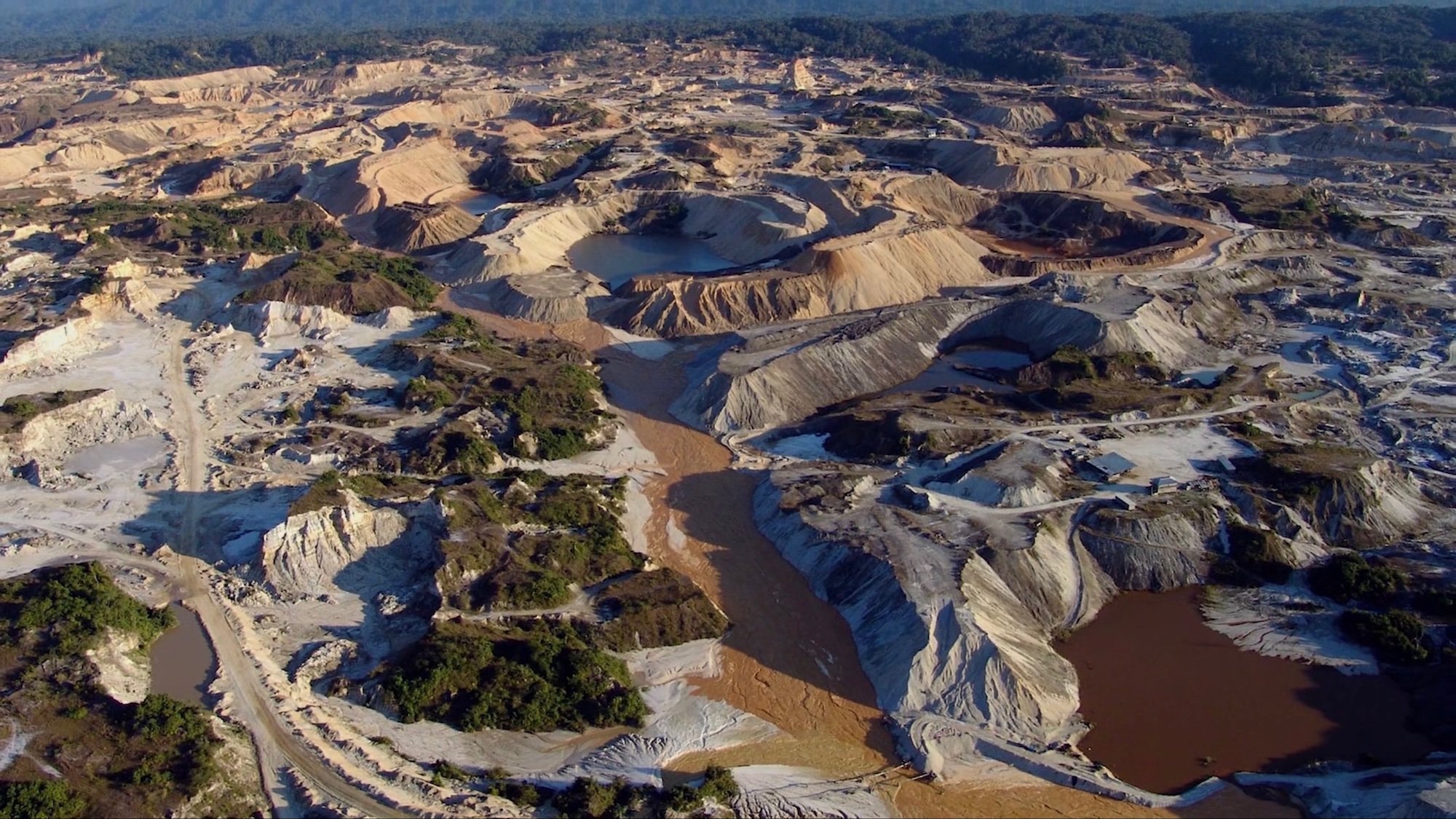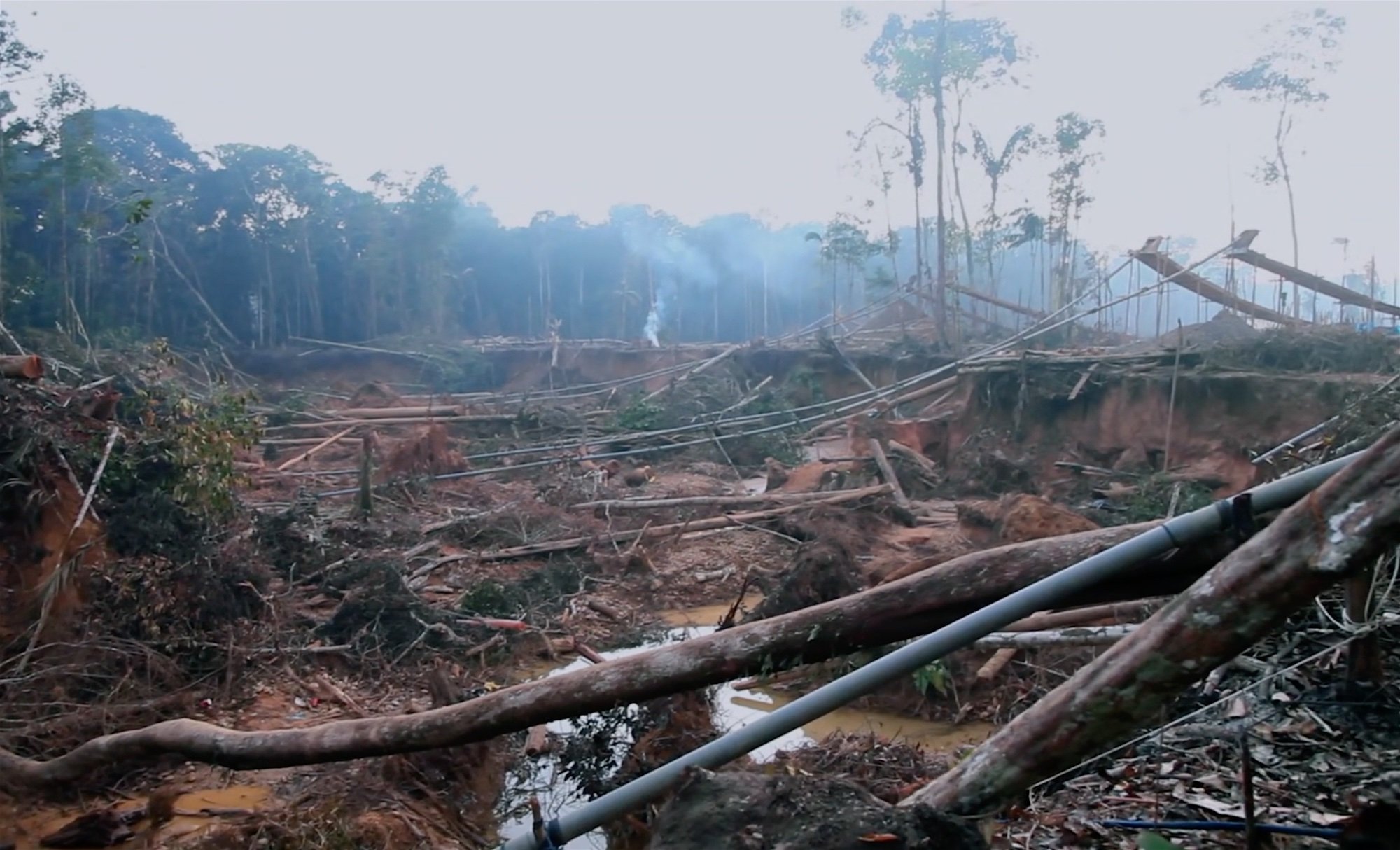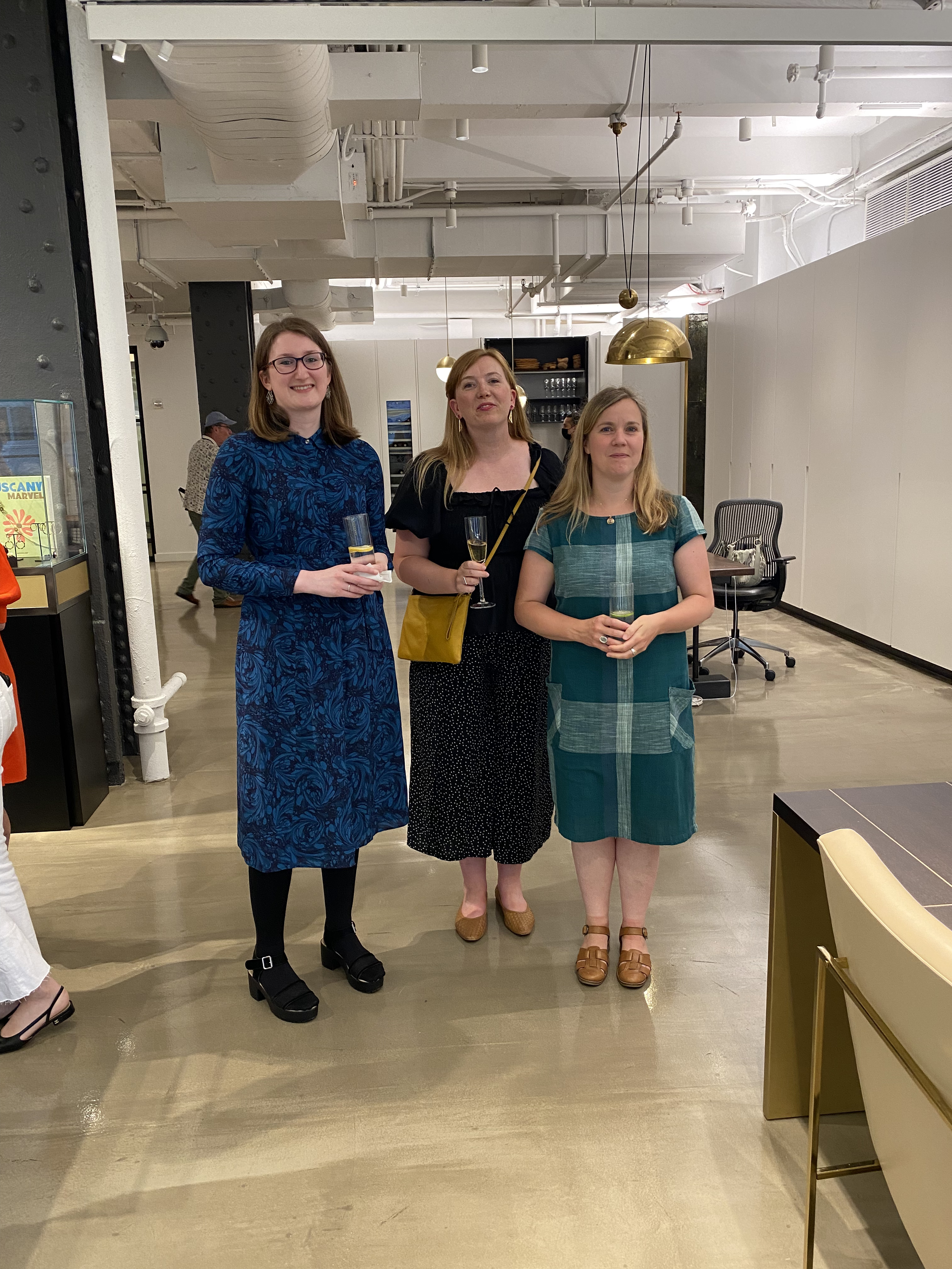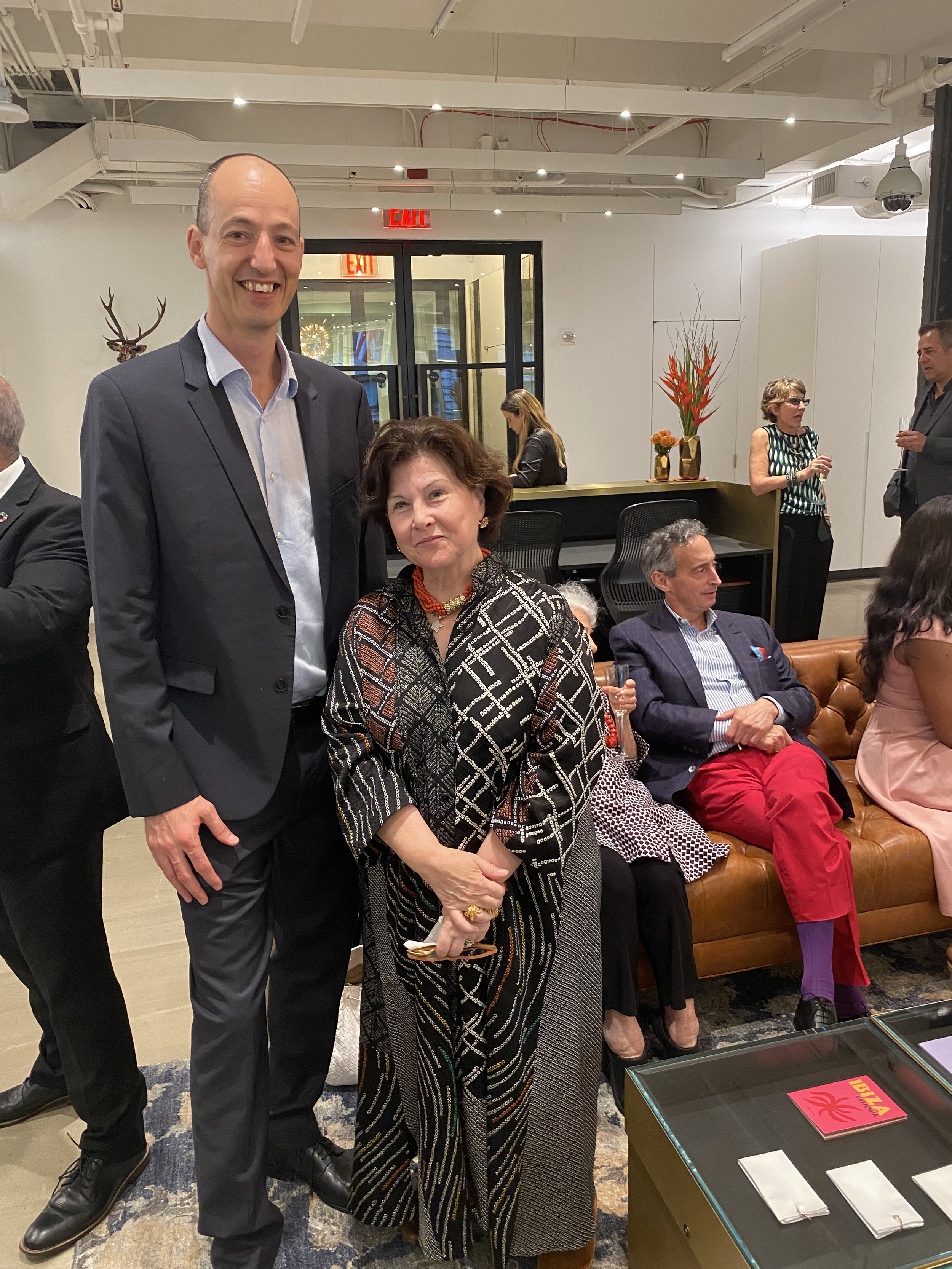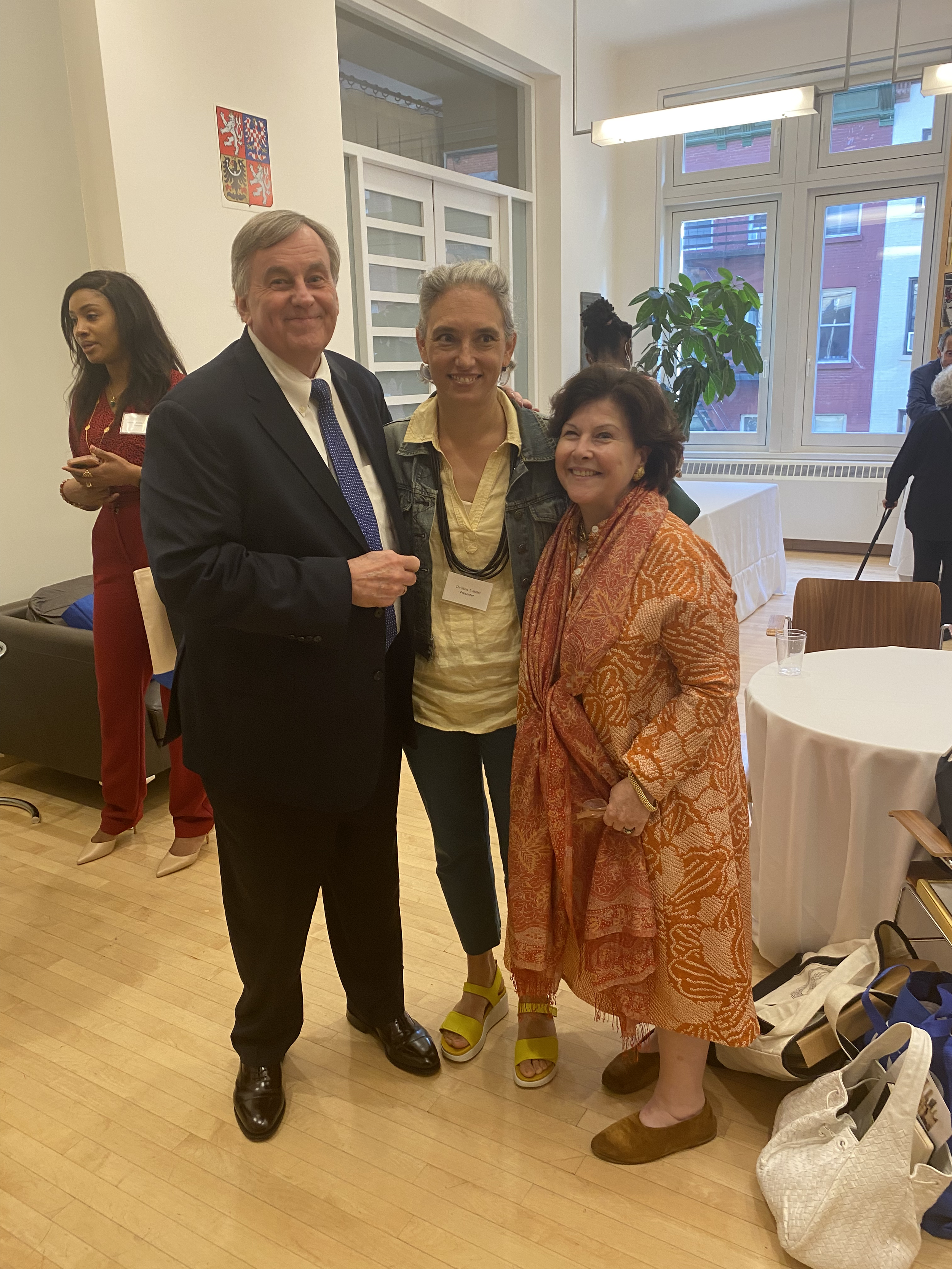Boldly Building the Future | Gold, Diamonds and Jewellery in a Transformational Age
Initiatives in Art and Culture, 12th Annual Gold and Diamond Conference
In July 2022 chief executive Ebba Goring and programme manager for Ethical Making Dr Karen Westland were invited to present The Scottish Goldsmiths Trust’s projects with a focus on the Ethical Making (EM) Pledge at the Initiatives in Art and Culture conference in New York. We also had the pleasure of being joined by Charlotte Dew, the public programme manager at The Goldsmiths’ Centre, London and are grateful to our partners on the EM programme and Dr Lisa Koenigsberg, president and founder of Initiatives in Art and Culture for supporting the trip. Through the presentation and panel discussion format, the conference was an opportunity for leading experts in the field to share their projects and network to create opportunities for learning and action. We were privileged to be able to share the endeavours of individuals and institutions in Scotland and the UK, as reflected in the expansion of the Ethical Making Pledge in 2022. To learn more about the Pledge please visit our Pledge Page. It was an intensive few days where we took an immense amount of notes, below we aim to summarise our 3 highlights from the conference based on ongoing collaboration to address both climate change and traceability challenges in our global gold and diamond industry.
The summary below was shared with associated speakers and we welcomed edits prior to publishing.
‘Climate Change and Planning for the Future’ panel during the conference. Image courtesy of Initiatives in Art and Culture
To contextualise the conference and information below, Dr Lisa Koenigsberg welcomed attendees and noted that we as humans instinctively glorify certain materials. Now, we explore the impact of having this practice: being present and looking into the future. This frames why we are here (and why you might be reading this article).
Climate Change and Planning for the Future
(Panel Moderator: Mark Hanna, CMO, Richline Group) Hélène Piaget: CEO Responsible Mining Foundation; John Mulligan: Director and Climate Lead, World Gold Council & President, Sustainable Development Commission, CIBJO – World Jewellery Confederation; Simone Knobloch: Chief Operating officer, Valcambi; Sarah duPont: Founder, Amazon Aid; Luis E. Fernandez: Executive Director CINCIA and Research Associate Professor of Biology, Wake Forest University.
[This panel was framed around the UN SDGs and the key outcomes from COP26 in relation to tackling climate change.]
John Mulligan noted that the scientific facts on climate change are undeniable as outlined in the IPCC's comprehensive 6th Assessment Report. Achieving net zero carbon emissions by 2050 is our way of stabilising the climate on Earth; that is, we need to halve carbon emissions by 2030 and achieve Net Zero two decades later to keep the climate temperature from rising above 1.5C (above the pre-industrial average). Emissions globally need to reduce by at least 7% annually to achieve this. 99% of gold supply chain greenhouse gas emissions are from gold mining. How mining generates and consumes electricity are key to reducing gold's carbon emissions. Gold mining decarbonisation can both benefit from and contribute to the global energy transition. COP26 in Glasgow focused on achieving Net Zero. Issues around who is responsible for addressing climate change and a ‘just transition’ will be part of the discussion at COP27 in Egypt, where the focus will also be around adaptation for developing communities to endure the accelerating physical impacts of the climate crisis.
Hélène Piaget warned that carbon counting does not encompass the other aspects of the social and environmental issues needed to be addressed. How can Climate Change exacerbate existing risks posed by mining? Water: too much or too little is problematic. Biodiversity: key for farming. Tailing Facilities: hold a major risk and climate change affects the stability of these facilities. Worker and community health: climate change exacerbates certain pest outbreaks, viruses and diseases: e.g. pandemic. Dust: issues around the mine site and trucks passing which impacts agriculture and livestock. Drought creates more dust. Helene continued to highlight that we need to remember legacy mines: how to make abandoned mines safe and back to an environmentally stable state and to improve security in mining communities: to avoid violating human rights: there is lots of reporting on the carbon footprint of mining activities, but not the social and environmental impact on the local area.
Simone Knobloch emphasised how chemicals have huge CO2 impact on Valcambi refining. Different products incur different CO2 levels. Simone explained a scale challenge: the smaller you go, the greater impact the gold refinement has, which is problematic for traceable ASGM (artisanal and small-scale gold mining). There are also issues country to country with energy used to mine and refine. Valcambi has created spreadsheets to calculate the carbon impact of gold products, based on the type of energy used and the refining scale/process adopted.
Sarah duPont advocated for the Amazon: which is considered one of the most important land ecosystems to support our climate. Research has shown that the Amazon rainforest needs approximately 80% of its trees to support our climate: we are currently around the 80% tipping point. As outlined in the River of Gold documentary film, there continue to be issues in conflict with indigenous people: among them mercury use, many human rights violations and crimes surrounding this operation. Furthermore, this illegal gold is finding its way into our legitimate supply chains.
Luis E. Fernandez illustrated his research into calculating the true price of gold. Supported by the images created by photographer Roberto (Bear) Guerra he explained how gold mining converts forests to water, and all the carbon that had been held in the water is lost. There is a gold – mercury – carbon connection: creating ecosystem disassembly. We need technology to extract gold from the earth without destroying the ecosystem.
Digging deeper into the science of the mercury moving through the ecosystem: when miners burn the gold/mercury amalgam, mercury fumes are absorbed by trees through the leaves. When the leaves fall, they are embedded into the land. The mercury is part of the trees and the soil at this point. When the forest is burned, the mercury is then re-emitted into the atmosphere, causing further issues. Luis is exploring reforestation in the Amazon: finding resilient trees and learning how to recreate the ecosystem in the dangerous gold mine landscape. Part of this is to understand how to face the cost and management of reforestation and bringing back fauna: its not about making a tree park.
Working toward solutions includes public and community education to mitigate impact, yet miners may not want to engage with a solution because they have been ’burned’ in the past. There is a scale challenge when working with ASM: you have to collaborate with a huge amount of people in a meaningful way. We can engage with consumers to build a demand for responsibly mined materials and create a loss of market credibility if you don’t have responsible sources for gold, diamonds etc. We can talk to energy suppliers to find out what is available to you to make positive change.
Questions to the room at large included: How do we sensitively collaborate with civil society and those who are on the ground? How do we educate about these issues without demonising the ASM miners, who are working in impoverished areas?
‘Origin’: Where do your gold and diamonds come from and why does it matter?
(Panel Moderator: Rob Bates, News editor JCK) Christina T. Miller: Christina T. Miller Sustainable Jewelry Consulting; Joanne Lebert: Executive Director, IMPACT; Angel Camacho, a criminal analyst with over 10 years’ experience working transnational organised crime matters, member advisory board for Amazon Aid; David Block: CEO Sarine Group; Olivier Demierre: President, Swiss Better Gold, Senior Vice President, Corporate Social Responsibility, MKS PAMP Group.
[Part of this panel discussion focused on the ongoing industry discussion around countries taking sanctions against Russian products, due to the ongoing Russia – Ukraine conflict. This session took a fluid discursive format, hence no speaker associations to the comments below.]
How do we bridge the gap between what is happening in the mines and in the jewellery studio? Origin of material is a central element of due diligence and the assessment of precious metal. As consumers of precious materials we don’t want to do any harm, but rather aim to do good.
UK and US Russian diamond sanctions prompt the importance of diamond origins and the process by which the rough is moved through different hands to the consumer. Venezuelan sanctions have been long lasting due to reporting issues: given the nature of their supply chains, diamonds are often entangled with other materials to avoid sanctions, and gold is no longer labelled as Venezuelan if moved through certain supply chains.
Gold is challenging to trace because it can be easily moved across some national borders, in addition to being a financial tool. There is generally a lack of awareness around gold supply chains: there are pockets of information but nothing cohesive nationwide (US) or internationally. Clients ask, ‘What do I do?’ all they can do is a written assurance that the gold or diamonds did not come from Russia. This assurance does not cover whether it came from another conflict area however. There are limited examples of proof provision for material origin. The London Bullion Market Association, as part of its Responsible Gold Guidance, requires precious metal refiners to identify the origin of the gold they source and perform appropriate due diligence on each source. Some suppliers have a sensitivity to traceability, but not all. Fortunately, awareness and action in this area are growing: retailers consider it as part of their commitment: clients are not necessarily asking questions, but due diligence is expected. The term ‘Conflict-free’ has been misleading to clients for the last 20 years: we need to bring clients into the complex situation: rather than turning them away from buying jewellery, we must strive to empower them to be able to ask questions about the provenance.
There is a need to explore all avenues of mining traceability: it can’t just be about the few best examples of traceability. If we want assurances from mining communities: we have to pay for this information. Mining communities will need to be incentivised; infrastructure needs to be created before traceability can occur. We need to offer better than the informal and sometimes illegal trade currently available. We need to understand and appreciate how artisanal and small-scale miners operate and the social culture of each community: to ask the people on the ground what they need, not project what we think they need. Large-scale mining (LSM) push for greater standards of operations: these could also help support artisanal and small-scale mining (ASM) by creating partnerships rather than being in opposition to another. Initiative for Responsible Mining Assurance (IRMA) offers a responsible mining standard that is governed by a multi-stakeholder board with equal voting power.
Diamond tracing: should there be a traceability threshold: i.e. traceable over a certain size/value? There are currently various methods including individual and batch diamond traceability. The chain of custody needs to be reliable but also efficient/affordable. Finding the technology for the task depends on demand and affordability (more challenging for small diamonds). Retailers are concerned about having some responsibly sourced products and the implication that their other products are not ‘ethical’. This emphasises the importance of being honest with clients and talking about traceability as a work in progress.
Tracing systems and technologies currently being explored were then outlined. Solutions exist that provide end users such as jewellers the possibility to receive end products that are the result of direct sourcing from a given mine or group of mines and then physically segregated. This allows end users to manage their sourcing risk but also, through initiatives such as Swiss Better Gold, to have an impact on the source social and environmental conditions by paying a premium that is reinvested for improvements on the ground. Over the past four years, Sarine’s technologies are being used to track diamonds along the pipeline from the mine to the consumer. Using advanced technology including artificial intelligence, we can collect and then feed data into our established algorithms to declare that a certain diamond comes from the same rough piece it was mined from. Sarine has provided technology to the diamond industry for over 30 years and have over 100 million diamonds pass through our systems each year. We can provide a fully automated and verifiable tracking of the diamond as it goes down the pipeline.
Chemical fingerprinting for gold involves aggregators in ASM playing a key role: individuals who are registered with their government could then bring gold into the traceable supply chain. This system involves micro-proofs: to help the overall traceability commitment. X-ray Fluorescence (XRF) portable devices are useful for analysing gold in mines from distant regions, but not neighbouring mines. The technology is also not currently applicable to gold that is not derived from hard rock. Fingerprinting is possible but not necessarily viable or able to mitigate risks. The issue with recycled gold is the limitations and difficulties to its traceability: there is no internationally agreed definition of ‘recycled gold’ which makes communicating about this product challenging, and often seen as a greenwashing ploy. [‘Recycled’ products can have transparency issues around their traceability.] Research into consumer awareness on gold origins noted that consumers are willing to put money toward materials with provenance but don’t know about issues of traceability till they are educated. The retailer needs to make consumers aware that this provenance exists in certain products.
Everyone involved directly or indirectly in the gold and diamond supply chains needs to be well informed on the issues around responsible sourcing. Explore connections to the supply network: where makers are supported with information: so we can enable due diligence. Create change from ‘I want to buy’, to specify what you want to buy: ‘I want to buy x’, then you can provide information and verify whether you can get the materials you want. There resides a stated preference (thinking) versus revealed preference (action): are those people who say they want responsibly sourced jewellery actually buying responsible jewellery? Are there opportunities where can we gain more action?
Rob Bates (left) in conversation with Edward Asscher (right). Image courtesy of Initiatives in Art and Culture
Facing forward: Update from the Kimberley Process and World Diamond Council
(Keynote conversation with Edward Asscher: President, World Diamond Council; with questions and prompts by Rob Bates, News editor JCK.)
Below is a recording for the conversation, courtesy for the World Diamond Council (WDC).
[This conversation raised the issues around the Kimberley Process, and whether it is fit for purpose, with a focus on the current Russian diamond controversy.
“The Kimberley Process (KP) is a commitment to remove conflict diamonds from the global supply chain. The core of this regime is the Kimberley Process Certification Scheme (KPCS) under which States implement safeguards on shipments of rough diamonds and certify them as “conflict free”.”
The United Nations established KP and is the basis of everything we [World Diamond Council (WDC)] do. To export diamonds, you need the KP certificate and imports need the certificate. You need the KP to do business. The KP has a review cycle: the current KP is a basis, but above this we do much more. The KP is not perfect: some KP certified diamonds involve conflict. It is mostly (99.8%) conflict free: a small percentage of illegal diamonds will slip through, like with any system. There is always risk of contamination.
The KP can be used to identify where there is disparity in exporting in countries which are not producing diamonds themselves: this can help identify this illegal activity and support convictions such as with Petra Diamond. You can’t generalise these issues: we need to look locally and tackle individual issues.
Alrosa is 1/3 owned by the Russian government. By the UN definition on conflict diamonds: Russian diamonds do not fit the description, so are not by law ‘conflict’ diamonds. The World Diamond Council (WDC) acknowledge that the current KP definition on ‘conclict’ diamonds is limiting, but while Russian diamonds are defined as non-conflict by law, if the WDC decide to boycott Russian or any type of legal diamond, they would become a cartel (which is illegal in the US and Europe). There are issues with the WDC taking a general stance: as there are countries that would like to work with Russia, but also those who wouldn’t. Asscher recommended people come to their own ethical conclusions on this matter.
The WDC are open to a ‘KP2’: it is a complex process, but we can build layers onto the original KP, to further reduce risk of conflict diamonds finding their way through the process.
The diamond industry is generally doing better in regulatory standards than other extractive industries, but there is a higher consumer/public expectation on the diamond industry. Accountability and transparency are no longer major issues in the diamond industry compared to 8 years ago. In recent years, there are issues of displacement of the natural diamond industry due to the ‘lab-grown’ diamond industry. We are making progress, but it takes time.
[This is an area of great controversy and disagreement. Since the conference in July, the KP Civil Society Coalition has called on the Kimberley Process to ‘come to terms with the shortcomings of the certification scheme and to commit to serious reform’. More up-to-date information can be found on the Kimberley Process Civil Society website.]
Conclusion
We hope this summary has piqued your interest for further research and to join this year’s Initiatives in Art and Culture (IAC) conference, taking place on July 17-19, 2023 in New York City! We welcome you to further research into the speakers, organisations and initiatives mentioned.
Thank you, Lisa, for welcoming us to the IAC conference in New York and for developing online events for year-round engagement on gold, diamonds, jewellery, and responsible practice.


